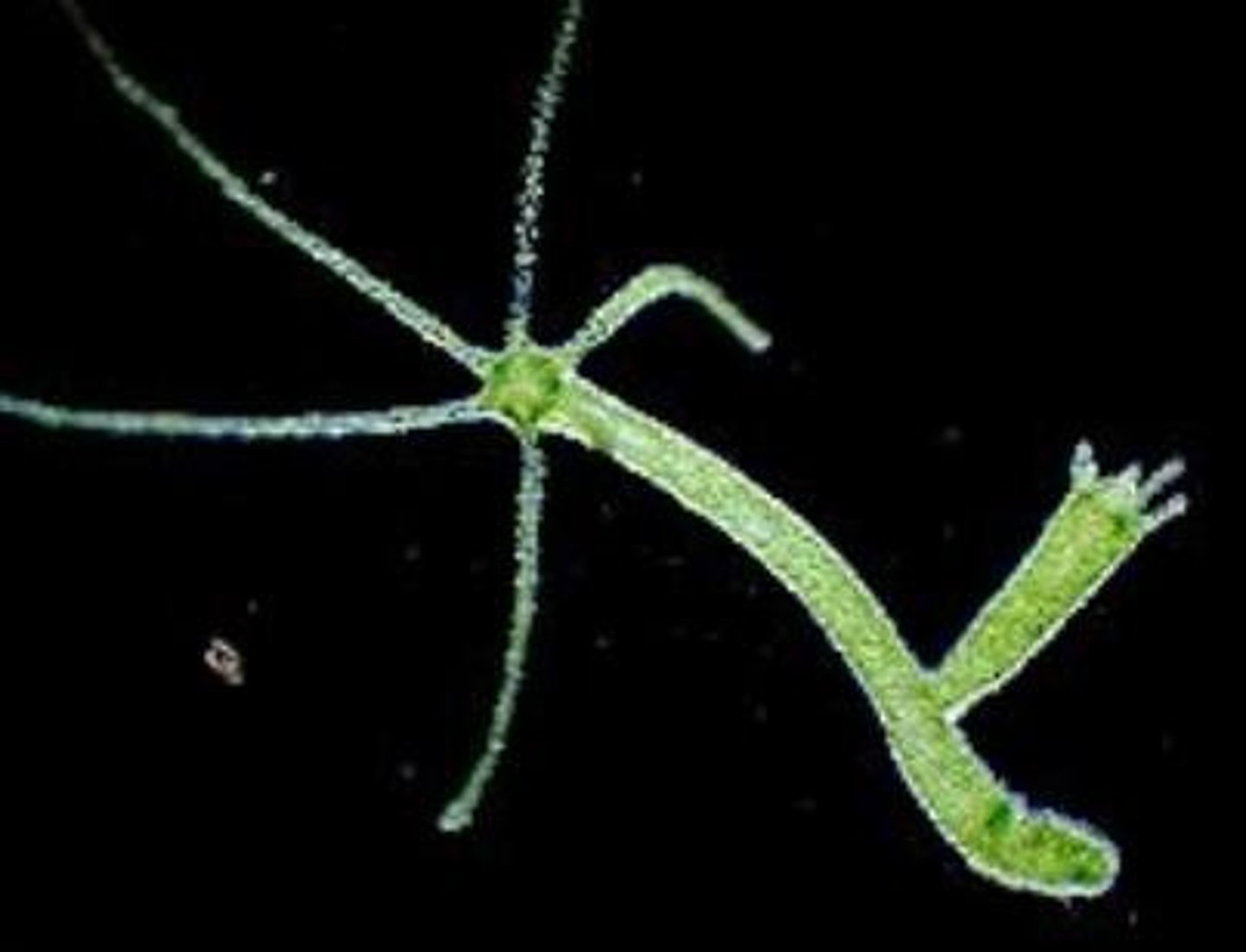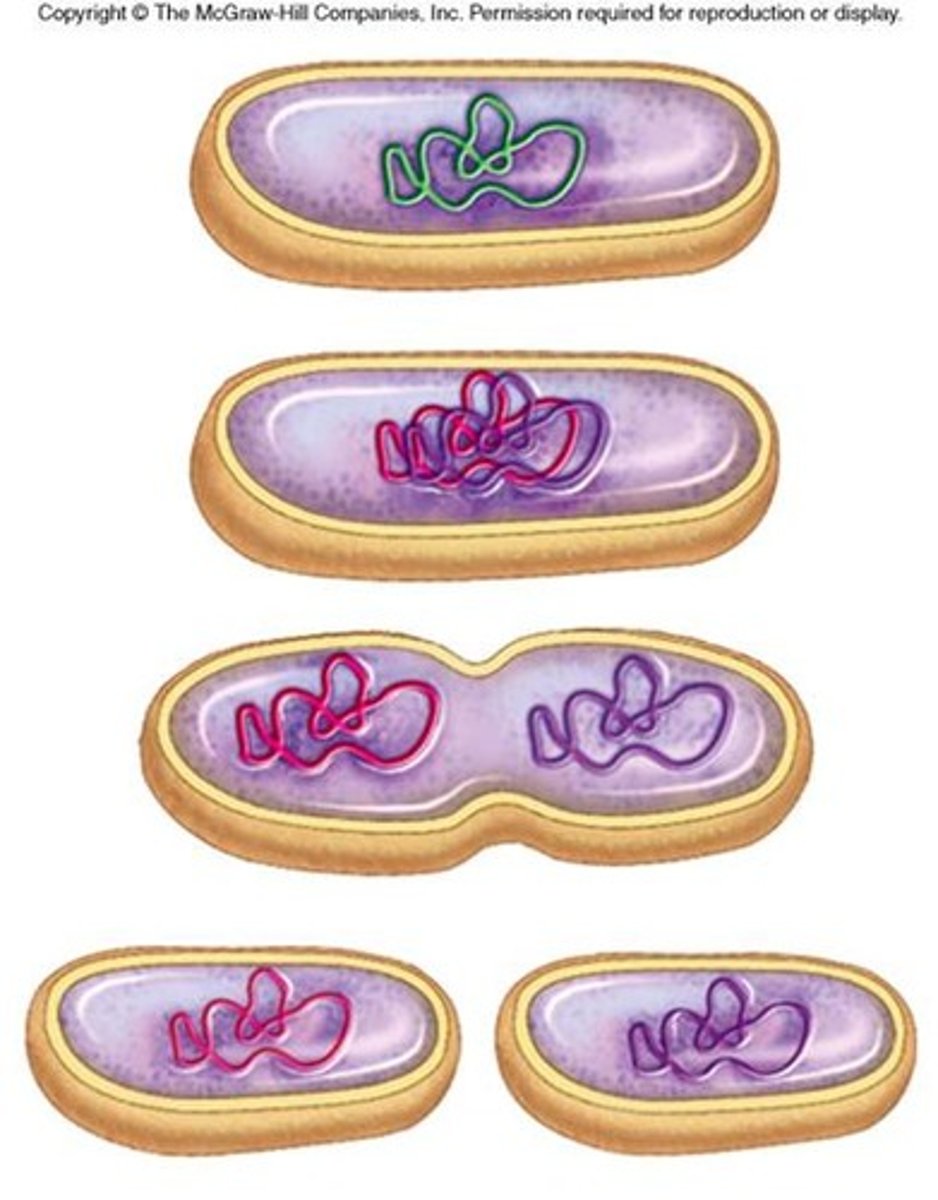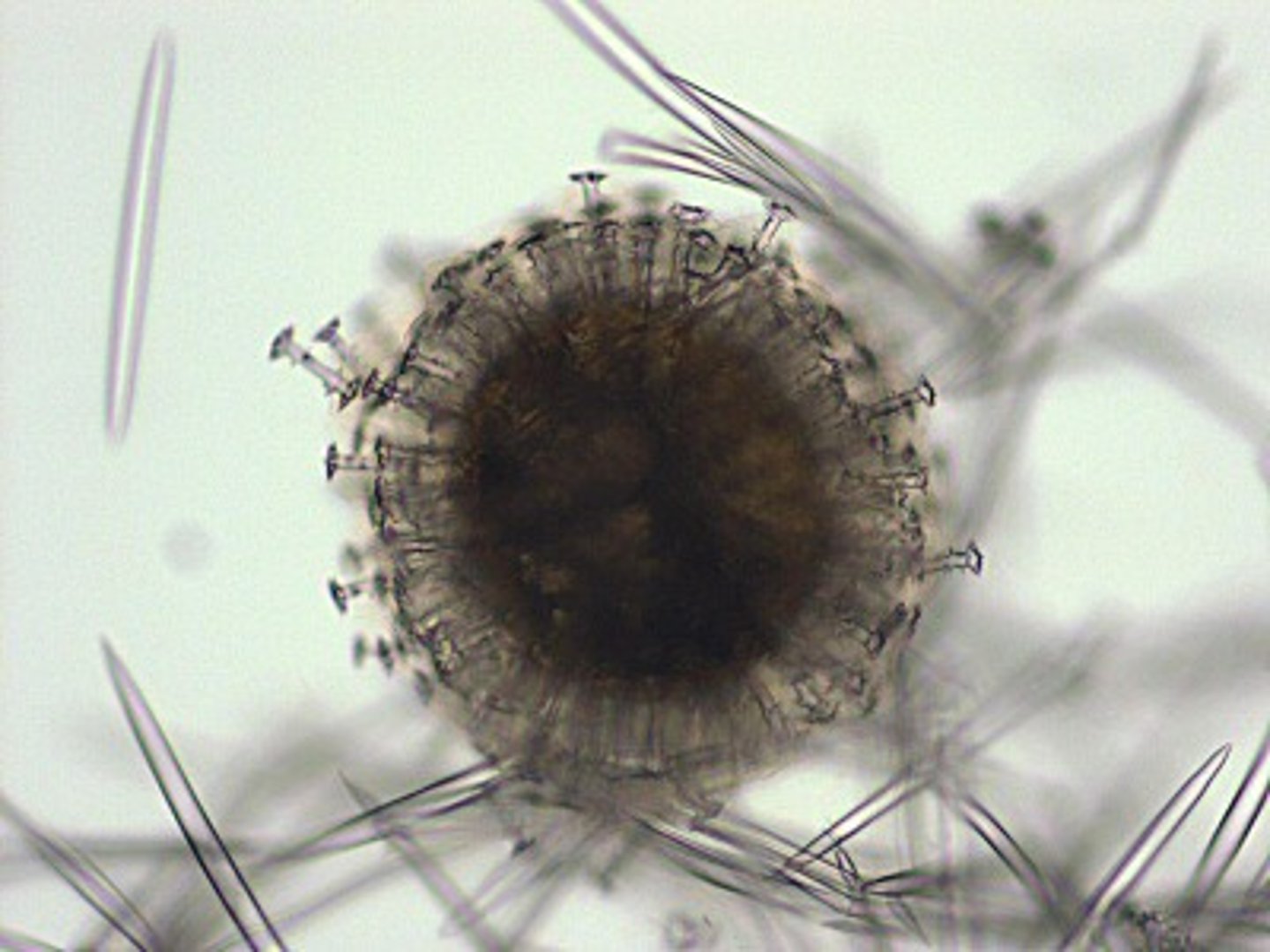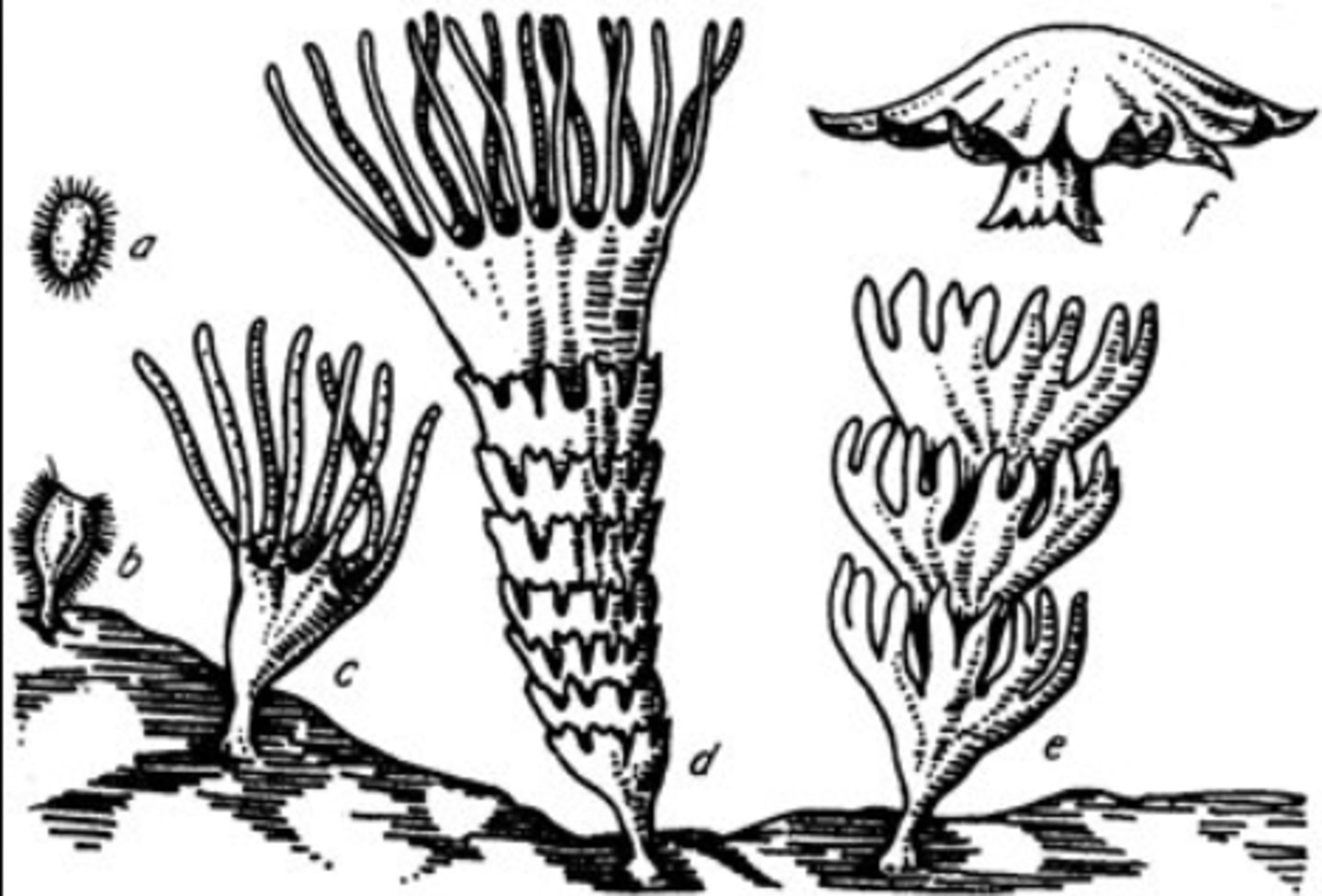MARB 215 Exam 2 (excluding unicellular eukaryotes)
1/152
There's no tags or description
Looks like no tags are added yet.
Name | Mastery | Learn | Test | Matching | Spaced |
|---|
No study sessions yet.
153 Terms
What are the different types of asexual reproduction?
budding, fission, gemmulation, fragmentation/strobilation
Define Budding
A type of asexual reproduction in which the cells divide. When the bud becomes large enough it breaks away and lives on its own (The offspring branches off from the parent)

Define Fission
The parent splits in half creating two genetically identical offspring.

Define Gemmulation
Packets of embryonic cells with a thick protective coating are formed internally.

Define Fragmentation/Strobilation
Segments become mature and are released

What does asexual reproduction produce?
offspring that are genetically identical to the parent
What are the advantages of asexual reproduction?
- rapid population growth
- only one parent needed
- requires less time/energy
- faster than sexual
What are the disadvantages of asexual reproduction?
- no genetic variation
- clones may all be susceptible to the same issues
(only adapted to one habitat; react same way to disease)
Asexual reproduction can be found mostly in
inverts (and parthenogenesis in verts)
What happens during sexual reproduction?
haploid gametes fuse together to form a diploid gamete
What does sexual reproduction produce?
offspring that are genetically varied from the parent
What are the advantages of sexual reproduction?
- genetic variation
- can adapt to environment --> survival advantage
- disease is less likely to affect a population
What are the disadvantages of sexual reproduction?
- lots of time/energy needed to find a mate and make gametes
- isolated individuals cannot reproduce
What is a hermaphrodite?
an organism which has both male and female reproductive elements (monoecious)
Hermaphroditism can be either
simultaneous or sequential
Simultaneous hermaphrodites
individuals that possess male and female reproductive functions at the same time
sequential hermaphrodites
individuals that possess male or female reproductive function and then switch to the other at a different time when needed
- protandrous
- protogynous
Protandrous hermaphrodites
first male (then FM)
Protogynous hermaphrodites
first female (then M)
What are the advantages of hermaphroditism?
- can always self-fertilize
or
- find a mate with anyone in their species
_____________________ arose independently in many lineages
hermaphroditism
Parthenogenesis is a type of
asexual reproduction
What is parthenogenesis?
It is a form of reproduction that happens without a male... an unfertilized egg forms embryo (due to lack of division during meiosis (meiotic) or absorption of polar body (ameiotic))
Sometimes parthenogenesis
requires sperm to be nearby for it to take place, however the sperm are not used in the embryo
Define external fertilization
gametes are fused outside of the parental body
What are the characteristics of external fertilization?
- generally in aquatic environments
- desiccation of gametes not an issue
- water currents help sessile animals colonize new environments
Two types of external fertilization are
1. Broadcast spawning
2. Demersal spawning
Define broadcast spawning
gametes are shed directly into water: gametes are small; fertilization happens by chance; no parental care
Define demersal spawning
females lay eggs in "nest" and male fertilizes: eggs generally bigger; some animals provide parental care
External fertilization can be found in
inverts (porifera, cnidarians, crustaceans, bivalves, echinoderms) and verts (most bony fish, frogs)
Define internal fertilization
fusion of the gametes happens inside the parent organism
Characteristics of internal fertilization
- usually inside the female
- exceptions: some members of class sygnathidae
- copulatory organs required
Internal fertilization males
require sperm, seminal fluids, and structures to transfer sperm to females
Internal fertilization females
require ova, accessory glands (shell/yolk production in some), ducts to connect seminal receptacle to oviducts
Internal fertilization can be found in
inverts (rotifers, acanthocephala, nematodes, gastropods, cephalopods) and verts (chondrichtyes, reptiles, birds, mammals)
Internal fertilization produces young in three ways
- oviparous
- ovoviviparous
- viviparous
Define oviparous
- egg laying; offspring hatches from egg
- all nutrition & gas exchange in egg
Define ovoviviparous
- internal eggs
- nutrition inside egg
- gas exchange through mother/father
- eggs hatch internally; live birth from parent
Define viviparous
- internal development of embryo with nutrition directly from mother
- live birth
What are the three different mating systems?
- monogamy
- polygamy
- promiscuous
Define monogamy
- 1:1 mater per breeding season
- 3-5% of mammals; 90% of birds
- common when offspring need biparental care
Define polygamy
- 1:many
- either polygyny
- or polyandry (less common)
Define polygyny
1 male, mult. female --> mother only care of young
Define polyandry
1 female, mult. males --> father only care of young
Define promiscuous
- many:many
- more common in social groups
- Individual cannot hold territory and monopolize a group of mates
-Social groups where all females become sexually receptive simultaneously
-Paternity often uncertain; selects for males to avoid infanticide
-Environment very unpredictable; high predation
Reproductive strategies are
structural, functional, & behavioral adaptations to improve chances of fertilization and offspring survival
What are the different reproductive strategies?
sexual/asexual reproduction, semelparous/iteroparous, sexual selection, male-male aggression with sneaky males, mate guarding, parental care
helps make sure next generation has their gametes
Define semelparous
reproduce one time in life
Characteristics of semelparous organisms
- put all energy into creating offspring; adult survivorship is not an issue
- litter may have a million+ eggs
- shorter generation times
Define iteroparous
reproduce multiple times over life
Characteristics of iteroparous organisms
- each batch offspring smaller than semelparous
- adult survivorship imperative; conserve energy for next litter
- longer generation times with overlapping generations
examples of semelparous organisms
some bony fish, insects, cephalopods, arachnids
Examples of iteroparous organisms
mammals, birds, reptiles, most fish, mosquitoes, roaches
Sexual selection
- most often by choosy females since females put more energy into creating gametes
- leads to sexual dimorphism
sexual dimorphism
Differences in physical characteristics between males and females of the same species.
Define male-male aggression with sneaky males
- Satellite/sneaky males
- Smaller, look more like female
- No chance of obtaining harem
- Sneak in to mate with females while large male preoccupied
- Is best chance to have their genes passed on
- Seen in many different animals: insects, frogs, birds
ex: elephant seals
Define mate guarding
- male remains close to the female after mating until eggs are fertilized to be sure no others mate with her
- copulatory plugs
What are copulatory plugs?/What do they do?
- sticky mass of ejaculate or portion of the copulatory organ
- can have chemicals in it to stimulate egg production or reduce FM attraction to M
- reduced risk of sperm competition from other males
- physically obstructs the seminal receptacle of female
- in some squids, nematodes, many mammals
What are the different types of parental care?
- biparental care
- paternal care
- maternal care
- allopatric care
Biparental care
- monogamous mating systems
- sexual selection not intense
- adult male: female ratio not skewed
Paternal care
- single parent
- polyandrous mating system
- more common in fish than other animals
Maternal care
- single parent
- polygynous and promiscuous mating systems
- females invest more in fewer/larger gametes --> may have favored maternal care
-prevalent in mammals due to location
Alloparental
- Seemingly altruistic
- Often in social species
- Caring for non-descendent offspring
- Why? Parental experience, reciprocal altruism,exploitation of young
- Mostly found in mammals, birds, and insects
What is r/K selection theory?
the tradeoff of quantity vs quality in offspring and best way to pass genes into next generation
- some animals can change selection strategy based on environmental conditions
r-selected
- Small investment goes into each offspring
- Often spawn/fertilize/disperse
- Each young has high probability of mortality
- Even if resources limited, some will survive
- Common in:
Lower quality environments and Animals with shorter lifespans
- Young are precocial
- more genetic diversity
Define precocial
mature rapidly with early independence
K-selected
- Young enter competitive world in a population at/near carrying capacity
- Few offspring with heavy parental investment (before & after birth)
- Higher probability of offspring survival
- More common in longer lived organisms in stable environments
- Young are altricial
Define altricial
- Born in an immature state and requiring care and feeding by parents
- Slower to mature and later to reach independence
C-selected
birth and death rates are relatively equal (birds and lizards)
Define preformation
- miniature adult in sperm/egg waiting to "unfold"
- used to explain development in 17th-18th century
Who came up with the theory of epigenesis and what does it mean?
- Kaspar Wolff
- "origin upon or after"
- building materials in fertilized egg are directed by "unknown forces"
What were the "unknown forces" Kaspar Wolff observed in the development of the chicks?
cytoplasmic specification and induction
What are the morphogenic determinants in oogenesis? (epigenesis)
- supports nutrition of the embryo
- directs development through cleavage
To aid in fertilization, eggs release species-specific _____________________ molecules to attract sperm (esp. in broadcast spawners).
chemotactic
Sperm have egg-recognition proteins on ____________ recognized by species-specific sperm receptors on egg
acrosomes
All animals have methods to allow penetration by only one sperm. What are some methods of reducing polyspermy?
- Chemical and/or physical change in vitelline layer
- Fertilization membrane (not in mammals) then formed to keep other sperm from entering
What is cleavage influenced by?
yolk amount and location
Holoblastic cleavage is
complete
Meroblastic cleavage is
incomplete
The different divisions of cleavage are
radial, spiral, rotational, and discoidal
What are the different types of eggs that affect cleavage?
telolecithal, centrolecithal, mesolecithal, and isolecithal
Isolecithal eggs
- little yolk throughout egg
- holoblastic cleavage
- direction of divisions can be radial, spiral, or rotational
- found in echinoderms, tunicates, mollusks, cephalochordates, and mammals (humans)

Mesolecithal eggs
- moderate yolk concentrated at vegetal pole
- holoblastic cleavage
- cleavage slower at yolk-rich pole (micromeres and macromeres)
- radial cleavage
- amphibians
Centrolecithal eggs
- much yolk concentrated in center
- meroblastic cleavage (superficial cleavage restricts cleavage to cytoplasm at rim of egg)
- arthropods (insects)
Telolecithal eggs
- much yolk concentrated at vegetal pole
- meroblastic cleavage (cleavage confined to narrow area on top of yolk)
- birds, reptiles, most fish, and some amphibians
Development of the egg depends on
the amount of yolk in the egg
Direct development
- high amounts of nourishing yolk in egg
- mini adult comes out of egg
- telolecithal
Indirect development
- lower amounts of yolk present in egg --> less nourishment
- newborn has a diff body than adult
- isoloecithal, mesolecithal
(mammals inc humans still have direct development due to placenta)
Continuous cleavage creates cluster of cells called the
blastula
Blastula
- all metazoans: single germ layer of cells in blastula
- most animals have fluid-filled cavity -- bastocoel
- no larger than zygote
- DNA has increased immensely
What happens during gastrulation?
the bastopore, 2 germ layers, and archenteron are formed
How is the mesoderm formed? (in triploblasts)
- schizocoely
- enterocoely
What happens in enterocoely?
the mesoderm is formed when the wall of archenteron pushes into space between endoderm and ectoderm; out-pocketing creates coelom
What is schizocoely?
the mesoderm is formed through the proliferation of cells near lip of blastopore; cells in center undergo programmed cell death & mesoderm splits open
Roux-Weismann Hypothesis (1800s)
genome from egg broken into smaller and smaller units with cell division; only information for individual cell types remain
Hans Driesch (late 1800s)
- proved R-W wrong
- shook apart 2-cell stage of sea urchins
- 1 cell died, but the other half-embryo developed into normal larvae
- all cells contain entire genome
Hans Spemann (early 1900s)
- separated salamander zygotes about to divide
- realized grey crescent was required for normal development
- Spemann organizer needed for induction
- Somatic Cell Nuclear Transport (SCNT) - cloning
Cytoplasmic specification
molecules in cytoplasm specify fate of cell
Induction
developmental response due to interactions with neighboring cells
What are the characteristics of cytoplasmic specification?
- cytoplasm is not homogenous
- morphogenetic components partitioned unequally throughout cytoplasm
- causes mosaic development of embryo
- many independently developing cells
- fate of the cell is not fixed until it receives positional info from neighbor cells
- differential spread of maternal mRNA in zygote
- all cells need to properly develop